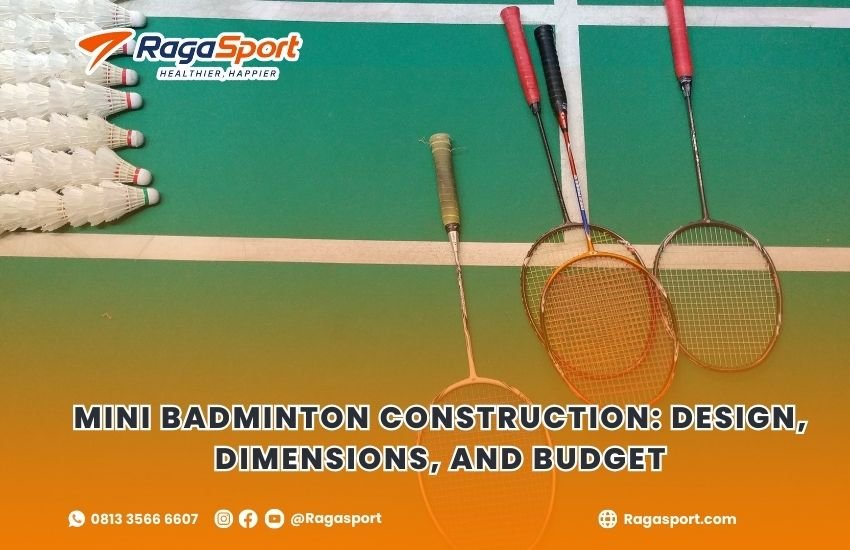Mini badminton courts are becoming increasingly popular in schools, youth sports facilities, and private properties. These compact courts are ideal for younger players and spaces where a full-size court is impractical. With proper planning, you can build a durable and functional mini badminton court that delivers excellent playing performance while staying within budget.
This guide explores everything you need to know about mini badminton construction — from court design and dimensions to materials and budget estimates.
Table of Contents
1. Mini Badminton Court Design Principles
1.1 Purpose-Oriented Design
Start by identifying the purpose of the court. Is it for recreational use, early training, or youth competitions? This decision will guide choices regarding flooring, lighting, layout, and overall court dimensions. A school playground may require a different approach than a private indoor setup.
1.2 Site Selection
Choosing the right location is critical. The site should be flat, safe, and preferably shaded if it’s an outdoor court. Indoor courts require sufficient ceiling height (minimum 5–6 meters) and good lighting. Make sure there is clearance around the court so players can move safely during matches.
1.3 Surface Considerations
Mini badminton courts can be built on a range of surfaces:
- Indoor: Wooden flooring, PVC, or PU mats with anti-slip properties.
- Outdoor: Concrete or asphalt finished with synthetic coating for grip and durability.
Regardless of surface type, ensure it supports foot traction and provides some level of shock absorption to prevent injuries.
2. Dimensions of a Mini Badminton Court
While a full-size badminton court measures 13.4 x 6.1 meters, mini courts are scaled down for children or limited space. The recommended dimensions depend on the age group and intended use.
Typical Mini Court Sizes:
| Age Group | Length (m) | Width (m) |
|---|---|---|
| Under 9 Years | 9 | 4.5 |
| Under 12 Years | 10.5 | 5 |
A common and versatile mini court dimension is 10 x 5 meters, which provides a balanced play area for most youth activities.
Other important measurements include:
- Net height: 1.55 meters at the posts and 1.524 meters at the center
- Clear zones: At least 1.5 meters around the court on all sides
- Indoor ceiling height: Minimum 5 meters
Court lines should follow standard markings but adjusted proportionally to the mini size.
3. Material Selection for Construction
3.1 Flooring Options
Choosing the right surface impacts both safety and game quality. Some common choices include:
- PVC or PU flooring: Ideal for indoor courts. Offers excellent cushioning and slip resistance.
- Wooden flooring: Suitable for multi-purpose indoor facilities and provides a professional play experience.
- Concrete with acrylic coating: A budget-friendly and durable option for outdoor courts.
3.2 Net and Post Systems
Use durable steel or aluminum posts with adjustable net systems. These can be fixed or portable, depending on your court type. Ensure the net is tensioned correctly and meets height regulations for consistent play.
3.3 Line Markings
For permanent courts, use anti-slip synthetic paint. For temporary or multi-use areas, removable thermoplastic tape is also suitable.
4. Estimated Budget for Mini Badminton Court Construction

The total cost to build a mini badminton court depends on the type of installation, surface material, and accessories. Here’s an approximate breakdown:
Estimated Cost Range (in Indonesian Rupiah):
| Component | Indoor Court (PVC/PU) | Outdoor Court (Concrete) |
|---|---|---|
| Site Preparation | 5,000,000 – 10,000,000 | 5,000,000 – 8,000,000 |
| Flooring | 30,000,000 – 50,000,000 | 20,000,000 – 35,000,000 |
| Net & Posts | 2,500,000 – 5,000,000 | 2,500,000 – 5,000,000 |
| Lighting (Indoor) | 10,000,000 – 15,000,000 | Optional |
| Line Marking | 1,000,000 – 2,000,000 | 1,000,000 – 2,000,000 |
| Total Estimate | 48,500,000 – 82,000,000 | 28,500,000 – 50,000,000 |
Note: Costs can vary depending on site location, material brand, and customization.
5. Court Maintenance and Longevity
Regular maintenance ensures your mini badminton court remains in good condition over time. Maintenance practices include:
- Sweeping and cleaning surfaces to prevent dust and debris buildup
- Checking the net for tension and wear
- Repainting faded or worn lines
- For outdoor courts: Inspect for cracks, water drainage issues, and surface integrity
For indoor courts, ensure lighting systems are checked regularly for optimal visibility.
6. Advantages of Building a Mini Badminton Court
- Cost-Effective: Lower material and construction costs compared to full-size courts
- Space-Saving: Perfect for small schools, urban communities, and private homes
- Youth-Friendly: Sized appropriately for children’s training and play
- Flexible Use: Can be installed both indoors and outdoors
- Easy to Maintain: Requires less cleaning, repair, and overhead cost
These benefits make mini courts an excellent investment for introducing the sport at an early age or offering casual play options in limited spaces.
7. Hiring a Professional Contractor vs. DIY
While DIY construction might save initial costs, hiring a professional ensures compliance with standards and quality workmanship. Experienced contractors bring:
- Accurate site leveling and measurement
- Proper application of flooring systems
- Regulation-based net and marking installations
- Reliable after-service and warranty
With professional help, your court is more likely to meet competitive standards and last longer.

Ready to Build the Perfect Mini Badminton Court?
Let Raga Sport turn your vision into reality with expert construction, top-quality materials, and a field that meets every standard.
👉 Explore our projects at ragasport.com
📲 Chat with our team now via WhatsApp: Click Here

